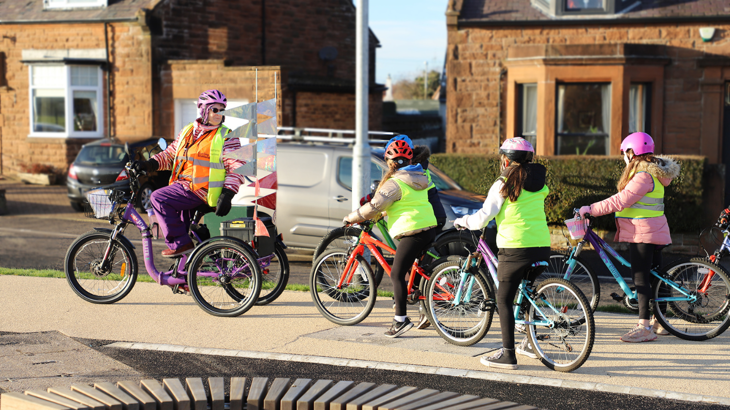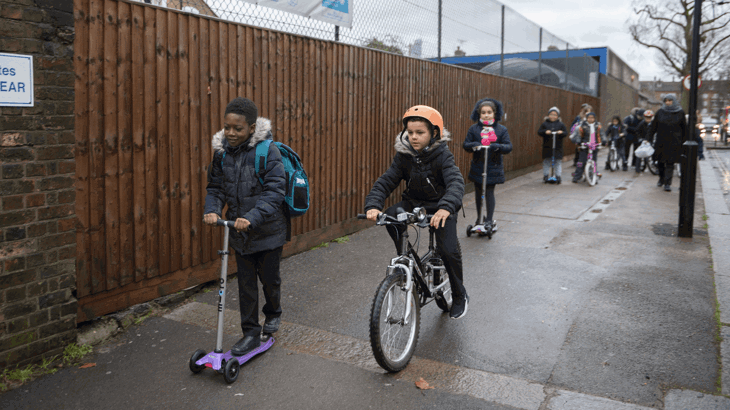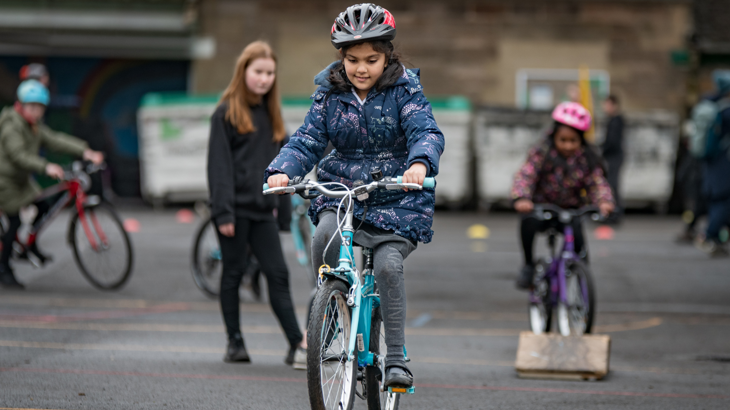New research has found that young people attending schools with active travel behaviour change interventions are walking, scootering and cycling more than national averages. And, if all Scottish primary schools were able to access multiple interventions, an additional 18,000 pupils could be travelling actively to school every day.

If each primary school in Scotland were to receive at least two interventions, there is an even bigger positive effect. Credit: Michael Kelly/Sustrans
Alongside other likeminded organisations in Scotland, Sustrans delivers several behaviour change and other school interventions with the aim of promoting active and sustainable travel among pupils.
These include the I Bike programme, Bikeability, Big Walk and Wheel, WOW Travel Tracker and the installation of cycle or scooter parking.
New analysis by Sustrans has shown that these interventions have a measurable, positive influence on the rate of active travel in Scottish primary schools.
But crucially, where there are two or more interventions, for example, I Bike and Bikeability, the combined positive effect on travel behaviours is even stronger.
Helping young people to thrive
Compared to largely consistent rates of active travel in Scottish schools overall, the research shows that young people attending schools involved with even one intervention are walking, scootering and cycling more.
And, the numbers of young people walking, scootering and cycling are even greater when they experience more than one behaviour change or school intervention.
The report has projected that an additional 18,000 pupils could be travelling actively to school if they are involved in two or more behaviour change interventions.
It also highlighted how 15,800 fewer young people would be walking, scootering and cycling every day if they had not been taking part in these interventions.
Without these interventions, Scotland could see a rise of up to 17.5 million additional car kilometres travelled over the course of a single school year.

The report uses data from the Hands Up Scotland Survey. Credit: Paul Tanner
How did we calculate the findings?
The new report uses data from the Hands Up Scotland Survey (HUSS) to first understand how pupils travel to school, whether by active travel, bus, park and stride, car or taxi.
The Hands Up Scotland Survey (HUSS) is an annual census of travel to school and has been carried out since 2008.
Researchers looked at which participating schools benefitted from interventions, including I Bike, Bikeability, Big Walk and Wheel, WOW Travel Tracker, scooter parking and cycle parking, and which did not.
We analysed the annual HUSS figures from 2016 to 2021, tracking how pupils travelled in schools that had active travel interventions and those that did not.
We then used this data to model three hypothetical scenarios:
- scenario A: no schools had interventions between 2016 and 2021
- scenario B: all schools had at least one intervention, some had more
- scenario C: all schools had at least two interventions, some had more.
The report then forecasts the impact over the next five academic years, from 2021 to 2026.
The findings presented here refer to the potential impact achieved after the ten years, from 2016 to 2026.

Research shows that primary schools with at least one behaviour change intervention have higher rates of active travel. Credit: Andy Catlin/Sustrans
What did we find?
The findings emphasise that where there are interventions, active travel remains at higher levels.
Plus, if each primary school in Scotland were to receive at least two interventions, there is an even bigger positive effect. This includes:
- an additional 18,000 pupils could be walking, scootering or cycling to school each day
- around 6.4 million additional active travel journeys in a year
- a reduction of 5,100 tonnes CO2e emissions per year.
However, if we lose the interventions completely, a total of 15,800 fewer children would be walking, scootering or cycling to school on an average day.
Over the course of a year, this could lead to around 6.8 million additional car journeys.
Recommendations
Removing I Bike, Bikeability, Big Walk and Wheel, WOW Travel Tracker, cycle parking or scooter parking from schools would result in a substantial drop in children walking and cycling to school.
This would have a negative impact on children's level of physical activity and their capacity to build positive lifetime habits.
Based on this research, we would strongly recommend retention of well-established interventions, such as Bikeability, which has been in place since 2007, and I Bike, which was first launched in 2009.
We also recommend expanding their use and, where possible, to have at least two interventions in each school.
This good work needs to continue so that new generations start and continue healthy habits for life.
Read the full report: Modelling the impact of active travel school interventions in Scotland.
Find out more about the impact of our work in schools in Scotland.





